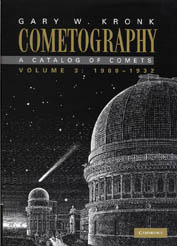 The Journal of the British Astronomical Association
The Journal of the British Astronomical Association
Volume 118, No.2: 2008 April
Detailed contents: Notes and News / Articles / Observers' Forum / Reviews / Letters / Meetings / BAA Update


Cover image
A view of the gibbous Mercury captured by NASA's Messenger on 2008 Jan 14 at a distance of 27,000km, 80 minutes after closest approach. A false-colour image with enhanced colour contrast made by combining images through red, infrared and ultraviolet filters. The bluest features are the youngest. The Caloris basin can be recognised in the lower left quadrant. South is uppermost. (This and all other Messenger images are provided by NASA/Johns Hopkins University Applied Physics Laboratory/Carnegie Institution of Washington. See the website at http://messenger.jhuapl.edu/index.php.) [This image forms Figure 1 of Dr Richard McKim's article in the Notes & News section below.]

 Notes and News
Notes and News
Messenger at Mercury, 2008 January (Richard McKim ) / From the President (Roger Pickard ) / Solar Section (Lyn Smith) / More supernova discoveries for Ron Arbour & Tom Boles (Stewart L. Moore) / Talking astronomy at Rathillet Primary School (Lyn Smith) / The opposition of Mars, 2007 - Interim report (Richard McKim) / Rob McNaught names asteroid for Harry Ford (Dave Gavine)
[Right: An almost-capacity audience for the talks at a recent Exhibition Meeting. Photo: Hazel McGee.]
Click here to obtain a PDF file of any of these articles
[Right: The Grade II Listed building of the Birmingham & Midland Institute. Photo: Stuart Williams]
Why not join us at a BAA meeting near you? Meetings are open to all and you will be made very welcome. Click here for the latest Meetings Diary
Search for all your leisure needs at
Back to top of page Refereed papers
Jupiter in 2001/2002: Part I ... John H. Rogers, Hans-Jörg Mettig, Michael Foulkes, Damian Peach & Antonio Cidadão
'Larrieu's Dam': the 'rediscovery' of a seldom explored topographical lunar feature in the foothills of the Rupes Altai ... Nigel Longshaw
Note on an early attempt to correlate visual and UV studies of Venus ... Richard Baum
Photometry and astrometry of SS Leo Minoris during the 2006 October superoutburst ... Jeremy Shears, David Boyd, Tom Krajci, Robert Koff, John R. Thorstensen & Gary Poyner

Meetings
 Joint meeting of the BAA and the Society for the History of Astronomy, Birmingham, 2007 April 21
Joint meeting of the BAA and the Society for the History of Astronomy, Birmingham, 2007 April 21
 Letters
Letters
Reviews

![]()
Prometheus Books, New York, 2007. ISBN 9781-59102-512-2. Pp 416, £19.99 (hbk).
 Reviewed by Lee Macdonald
Reviewed by Lee Macdonald
![]()
Cambridge University Press, 2007. ISBN 978-0-521-58506-4. Pp 650 + xvi, £150.00 (hbk).
 Reviewed by Jonathan Shanklin
Reviewed by Jonathan Shanklin
CLICK HERE to read scores more authoritative book reviews from the BAA Journal



 Observers' Forum
Observers' Forum

 BAA Update
BAA Update
 Sky notes for 2008 April & May by Neil Bone
Sky notes for 2008 April & May by Neil Bone